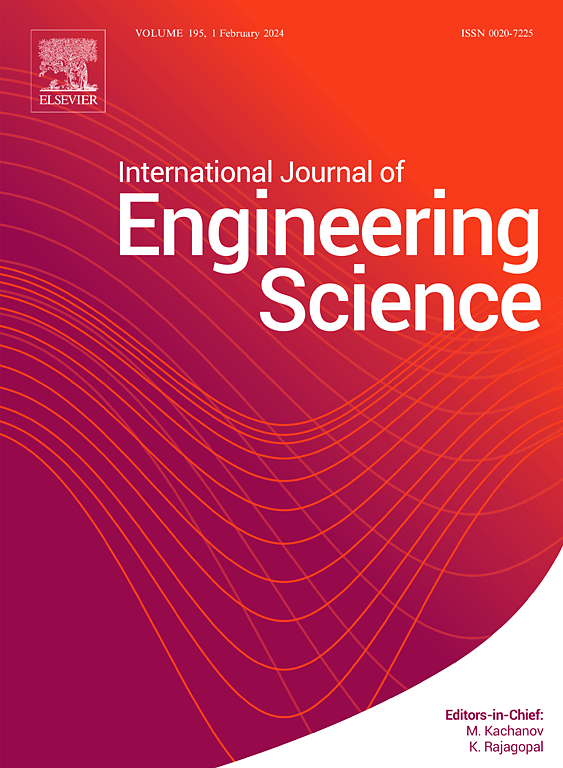一种新的应变梯度粘塑性自洽晶体塑性模型,用于预测几何上必要的位错和长度相关的力学响应
IF 5.7
1区 工程技术
Q1 ENGINEERING, MULTIDISCIPLINARY
International Journal of Engineering Science
Pub Date : 2025-10-09
DOI:10.1016/j.ijengsci.2025.104396
引用次数: 0
摘要
本文描述了一种第一应变梯度粘塑性自洽晶体塑性模型的表达式。SG-VPSC模型是基于由多晶聚集体中应力场的第二矩引起的晶格旋转速率波动估计的颗粒内取向扩展。取向扩展在空间上排列,以获得每粒旋转张量场的函数形式,用于计算空间导数。然后取与“旋度”操作相关的空间导数,从每个晶粒的旋转张量场中获得奈位错张量。Nye张量最后用于计算每个晶粒的几何必要位错(GNDs)密度。将基于位错密度的硬化规律和先进的复合晶粒模型扩展到包括GNDs的影响。通过不同初始晶粒尺寸的α-Ti试样沿两个方向压缩和AA6016-T4的应变路径变化变形条件,验证了SG-VPSC模型在模拟多晶金属中包括GNDs在内的微观组织演变过程中的潜力和实用性。本文章由计算机程序翻译,如有差异,请以英文原文为准。
A new strain gradient viscoplastic self-consistent crystal plasticity model for predicting geometrically necessary dislocations and length-scale dependent mechanical response
This paper describes a formulation of the first strain gradient (SG) viscoplastic self-consistent (VPSC) crystal plasticity model. The SG-VPSC model is based on the intragranular orientation spreads estimated from the fluctuations in the lattice rotation rates stemming from the second moments of the stress fields in the grains of a polycrystalline aggregate. The orientation spreads are spatially arranged to attain a functional form of the rotation tensor fields per grain for the calculations of spatial derivatives. The spatial derivatives pertaining to the “curl” operation are then taken to obtain the Nye dislocation tensor from the rotation tensor fields per grain. The Nye tensor is lastly used to calculate the density of geometrically necessary dislocations (GNDs) per grain. A dislocation density-based hardening law and an advanced composite grain model for twinning available in VPSC are extended to include the effects of GNDs. The potential and utility of the developed SG-VPSC model to simulate the mechanical response and concomitant evolution of microstructure including GNDs in polycrystalline metals are demonstrated using a few simulation case studies including compression of α-Ti specimens with different initial grain sizes along two specimen directions and a set of strain-path change deformation conditions applied to AA6016-T4.
求助全文
通过发布文献求助,成功后即可免费获取论文全文。
去求助
来源期刊

International Journal of Engineering Science
工程技术-工程:综合
CiteScore
11.80
自引率
16.70%
发文量
86
审稿时长
45 days
期刊介绍:
The International Journal of Engineering Science is not limited to a specific aspect of science and engineering but is instead devoted to a wide range of subfields in the engineering sciences. While it encourages a broad spectrum of contribution in the engineering sciences, its core interest lies in issues concerning material modeling and response. Articles of interdisciplinary nature are particularly welcome.
The primary goal of the new editors is to maintain high quality of publications. There will be a commitment to expediting the time taken for the publication of the papers. The articles that are sent for reviews will have names of the authors deleted with a view towards enhancing the objectivity and fairness of the review process.
Articles that are devoted to the purely mathematical aspects without a discussion of the physical implications of the results or the consideration of specific examples are discouraged. Articles concerning material science should not be limited merely to a description and recording of observations but should contain theoretical or quantitative discussion of the results.
 求助内容:
求助内容: 应助结果提醒方式:
应助结果提醒方式:


